|
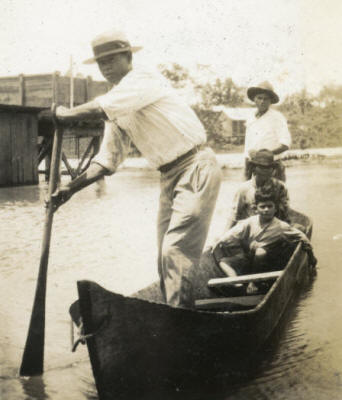 THIS IS THE THIRD PAGE
of documents for the FIRST HALF of 1931
on Nicaragua's Caribbean Coast region, housing
materials dated in the 22 days from April 1 to April 22. In fact, so
much was happening in these heady days of Gen. Pedro
Blandón's assault on the environs of Puerto Cabezas that
documents dated April 22 continue onto the next
page.
THIS IS THE THIRD PAGE
of documents for the FIRST HALF of 1931
on Nicaragua's Caribbean Coast region, housing
materials dated in the 22 days from April 1 to April 22. In fact, so
much was happening in these heady days of Gen. Pedro
Blandón's assault on the environs of Puerto Cabezas that
documents dated April 22 continue onto the next
page.
The collection opens with
an excerpt from Gen. Blandón’s April
7 missive to Sandino describing his
troops’ beheading of the Moravian
missionary Otto Bregenzer (as
published in Somoza’s El
verdadero Sandino), which can
be fruitfully read in tandem with
the letter of Bregenzer’s widow
Elizabeth (22 April). The page
combines a flurry of Marine-Guardia
reports on the rebels’ attacks on
Logtown, Moss Farm, Vacarro Farm &
other foreign-owned properties on
the outskirts of Puerto Cabezas; a
series of reports from
Marine-Guardia field officers on
their counter-offensive on land &
from the air; a string of telegrams
between US Minister Hanna in Managua
and Secretary of State Stimson in
Washington (as published in the
Foreign Relations of the United
States series); and all extant
documents from the EDSN side,
including the original Juramento
(Oath) required by Blandón of his
troops, taken from his body along
with several other EDSN documents.
Comparing & contrasting Sandino’s
account of Blandón’s death (13
April) with Marine-Guardia versions,
as these appears in various reports,
offers a fascinating window on how
each side saw & represented the
unfolding struggle.
Was
the rebel offensive a success or
failure? The answer,
as it emerges from these & later
documents, is ambiguous: while
the EDSN failed to take Puerto
Cabezas or any other major town,
their surprise offensive did spark a
major shift in US policy, prompting
Stimson to announce that US military
forces could no longer guarantee the
lives or properties of US citizens
in Nicaragua. Key synopses of
events include Major Mitchell’s
report on the use of air power to
repel the rebel assault (14 April)
and the 11-page report by Capt. Wood
(22 April) — though even more
detailed & revealing accounts will
emerge in the weeks & months to
come.
|
|
PERIOD MAPS
|
|
1894 mosquito
shore

27 MB,
library of congress
|
1920s
Standard Fruit

6.5 mb,
US National archives
|
1928 Rio wanks
Patrol

3 mb, us
national archives
|
1931 Moravian

2.4 mb,
comenius press
|
|

|
7 April
1931.
Report from Gen.
Pedron Blandón, his camp, to Gen.
A. C. Sandino, Cuartel General.
From
Anastasio Somoza Garcia,
El verdadero Sandino o el
calvario de Las Segovias
(1936), pp. 220-21. "MISIONERO
MORAVO QUE CAE EN PODER DE PEDRO BLANDÓN
¶ Existe en la Costa Atlántica una
institución religiosa llamada Misión
Morava, integrada por virtuosos
sacerdotes de distintas nacionalidades:
suecos, alemanes, ingleses, etc. La sede
de la Referida Misión se encuentra en
Puerto Cabezas y la cabeza principal es
el Reverendo Grossman, quien dirige las
actividades espirituales de los Pastores
y asociados. Estos Misioneros son
enviados a desempeñar su evangélica
labor de catequizar a los zambos e
indígenas que pueblan las riberas del
río Coco, lo que han hecho con magnífico
resultado. En tales labores se
encontraba el reverendo Otto Brezenger
[Bregenzer] cuando cayó en poder del
cabecilla sandinista Pedro Blandón,
quien por ese tiempo había invadido la
Costa Atlántica con sus fuerzas. ¶
Oigamos el relato, todo él desposeído de
verdad, que hace Blandón a Sandino, con
fecha 7 de Abril de 1931, acerca de la
captura y muerte del infortunado
misionero, respetando su ortografía
original: ¶ “El 30 de marzo salimos de
San Pedro de Pis Pis, y llegamos el 31
del mismo a Musaguaz donde encontramos
un hombre que los zumos le dicen Padre,
el cual era un reportero del Jefe de la
Guardia de las minas y de Puerto Cabezas
quien les daba informe de todas las
operaciones desarrolladas por nuestras
fuerzas en esas regiones. ¶ Preguntado
por mí, revestido con toda la autoridad
que me caracteriza, que cual era su
misión en nuestro territorio, contestó
que los indios zumos habían enviado una
acta firmada por todos ellos pidiendo al
gobierno de Estados Unidos de Norte
América, que les diera quien los
instruyese porque aquí no había quien
los civilizara, y entonces el macabro
gobierno de EE.UU. de N.A. lo había
mandado a él. ¶ Este era un miserable
engañador a los indios y por lo tanto
los tenia oprimidos y los explotaba de
una manera tan brutal, que al instante
que recibimos los informes de la
conducta de él no pude menos que MANDAR
SEPARAR LA CABEZA DEL CUERPO. Se llamaba
Kabrigenser [Bregenzer], de nacionalidad
norteamericana pues le encontramos sus
credenciales, pasaportes y demás
documentos pertenecientes a él, donde no
nos quedó duda que era Americano. ¶ Todo
lo útil para nuestro Ejército ordenamos
que se trajera, y quemamos la casa que
era propiedad de ese cabrón.” ¶ Es de
creer que el relato anterior no es más
que para justificar el crimen cometido
en la persona de un hombre esencialmente
pacífico, perteneciente a la Misión
Morava, que como es sabido de todos los
nicaragüenses, no se inmiscuye en
asuntos políticos. Hemos de observar
también que el Reverendo Brezenger
[Bregenzer] no era Americano sino de
nacionalidad alemana siendo falso por
consiguiente que se le haya encontrado
papeles que justificaran el aserto de
Blandón. El Rvdo. Brezenger [Bregenzer]
murió con el crucifijo en una mano y el
Evangelio en la otra, mientras en sus
labios sólo hubo palabras de perdón para
sus fieros victimarios. ¶ Más adelante,
en el mismo documento transcrito, da a
conocer Blandón a Sandino, su modo de
proceder en los Minerales de “Neptuno”,
haciendo sin necesidad daños
incalculable al pais entero. Dice así: ¶
“Se me había olvidado informarle que el
motor del dinamo que movía todas las
máquinas de la Mina de “El Neptuno”
ordenamos romperlo con dinamita y así
sucedió quedó en escombros y está
paralizado el trabajo de dichas minas.”
¶ Pareciera que se tratara de dejar sin
trabajo a la gente para hallar una forma
de encontrar prosélitos, obligados por
la necesidad. ¶ LA PROTESTA DEL
MINISTRO DE ALEMANIA POR LA MUERTE DEL
MISIONERO BREZENGER ¶ Para que
se conozca la verdadera nacionalidad del
misionero muerto por Blandón,
desmintiéndose de manera enfática lo
dicho por el cabecilla Sandinista, véase
la nota enviada a nuestra Cancillería: ¶
Legación de Alemania en Centroamérica y
Panamá, Guatemala , 17 de Abril de 1931.
Sr. Ministro: . . . "
|
|
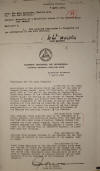
|
7 April
1931.
Report on Formation of a Bluefields
branch of the Liberal Military League.
Col. John
Marston, Bluefields, to Jefe
Director GN, Managua.
|
|
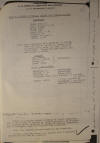
|
12 April
1931.
List of Foreign Civilians Killed Near
Puerto Cabezas (no author), from
Commander Special
Service Squadron,
USS Rochester,
ca. 12 April.
|
|
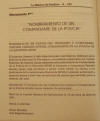
|
12 April
1931.
Gen. Pedro
Blandón, Nominación en Favor del
Hermano y Compañero Capitan Tarcisio
Hundel Comandante de La Policía de la
Hacienda Moss.
|

 |
12 April
1931.
Gen. Pedro
Blandón, Juramento (two images,
n.d.).
"Juramento
Para Abanderados y Ayudantes de Bandera
- "Jurais por vuestro Honor Militar, y
para honra de nuestra Patria, defender
la Bandera que flamea en nuestra
Columna, aún a costa a tus propias
vidas? R. Si, juro. Si así
lo hicereis la Justicia Divina ós
premiará y si no ós castigará. En
vuestros manos entrego el tesoro más
sagrado que tiene nuestra Amada
Nicaragua."
Source:
NA127/E38/Box 30. Scan of
photocopy of original, stamped "Bandit
Correspondence," captured by Capt. Wood,
taken from body of Blandón.
NOTE: This version is
different than that appearing in
Alejandro Bendaña, La mística de
Sandino (Managua, 1994), Doc. 8, p.
190, which reads as follows:
"Juran por su Honor Militar y por el
honor de nuestro país defender la
bandera que ondea en nuestra Columna,
incluso al costo de sus propias vidas?
Respondan: Si, lo juro. Si así lo
hicieran, la Divina Justicia nos
reconocerá y si no los castigará.
En sus manos entregó el tesoro más
sagrado que tiene nuestra querida
Nicaragua." In light of these
differences, it seems likely that
Bendaña's is a Spanish translation of an
English translation of the Spanish
original.
|
|
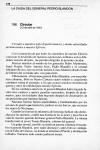
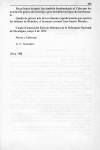
|
13 April
1931.
Circular (on death of Gen. Pedro
Blandón).
Gen. Augusto C. Sandino, Cuartel
General del EDSN (2 images).
"LA
CAIDA DEL GENERAL PEDRO BLANDON ¶ 186
Circular (13 de abril de 1931) ¶
Circular a nuestros Jefes
Expedicionarios y demas autoridades
pertenecienes a nuestro Ejercito. ¶ Con
la intencion de que todos los miembros
de nuestro Ejercito conozcan el
desarrollo de nuestras operaciones
militares en los diferentes sectores del
pais, me permito dirigirles la presente
circular: ¶ Fuerzas nuestras al mando de
los generales Pedro Altamirano, Israel
Peralta, Pedro Antonio Irias, Pedro
Blandon y el coronel Abraham Rivera, han
recorrido nuestra Costa Atlantica desde
el mes de febrero del corriente ano, con
gran exito. ¶ Ultimamente, el hermano
general Pedro Blandon, con una poderosa
columna, libro en Puerto Cabezas cuatro
renidos y sangrientso combates contra el
enemigo, a los que avanzo muchos
elementos de Guerra y otros de utilidad
para nuestro Ejercito. ¶ En los combates
anteriores el general Blandon habia
logrado fusilar once Yankees y quince
guardias nacionales, despues de
desarmarlos, pues los fusilados iban
huyendo despues de desalojarlos de sus
posiciones por nuestras fuerzas. ¶
Nuestras fuerzas fueron ametralladas y
bombardeadas por los avione de Guerra
que tienen los Yankees en sus barcos,
que recorren los mares de Nicaragua. ¶
Cuando las fuerzas de infanteria del
enemigo habian sido deshechas por las
nuestras, estallo una bomba de los
aviones y puso fin a la vida de nuestro
querido hermano general Pedro Blandon.
La misma bomba mato al joven Tomas
Blandon, sobrino del general. ¶ Un golpe
mortal, terrible, se sintio en nuestra
columna al sucumbir el general Blandon,
pero nadie desmayo y antes bien se
condujeron al Cabo de Gracias, en donde
se tomaron el Puerto y destruyeron la
Radio. Tomaron todo cuanto pudieron
tomar. ¶ Pocas horas despues fue tambien
bombardeado el Cabo por los aviones de
Guerra del enemigo, pero no hubieron
bajas de nuestra parte. ¶ Quedo de
primer jefe de la columna expedicionaria
que opero a las ordenes de Blandon, el
hermano coronel Juan Santos Morales. ¶
Cuartel General del Ejercito Defensor de
la Soberania Nacional de Nicaragua, mayo
4 de 1931. ¶ Patria y Libertad ¶ A. C.
SANDINO."
|
|
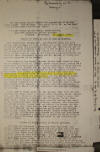
|
1.
14 April 1931.
Operations of Marine Corps planes from
Managua on East Coast during bandit
activities April 12-14,
Major R. J.
Mitchell, Managua, p. 1.
"The following
report covers the operations of Marine
Corps planes from Managua from April 12
to 14 on the East Coast during bandit
activities there: ¶ “United States
Marine Corps, Headquarters, ¶ Aircraft
Squadrons, Second Brigade, ¶ Managua,
Nicaragua, 14 April 1931. ¶ Report of
Plane Patrol to Puerto Cabezas ¶ Two
observation landplanes, Lieutenants
Young and Jack pilots, left Managua at
0?10, Sunday, 12 April, arriving Puerto
Cabezas at 1030. The planes were gassed
and information was obtained as to the
probable location of the bandits. At
1140 the two planes left on patrol, and
headed for a large cloud of smoke, which
could be seen in the distance at
approximately the place at which
Lieutenant Darrah and his patrol of
twenty-two men were supposed to be
located. ¶ Upon reaching the smoke,
several houses were found on fire but no
bandits could be located. These houses
were located on a three-mile long
railroad spur, at the junction of which
and the main line Lieut. Darrah and his
patrol were found. They appeared in good
shape and motioned in the direction of
the burning houses. The planes proceeded
to search this area very thoroughly,
dropping bombs on suspicious looking
places, but were unable to route out any
bandits. In the meanwhile Lieut. Darrah
took his patrol down the entire length
of the spur, searching every house and
box car, but met with no success, and
finally signaled the planes that no
bandits could be found. Upon seeing
these signals, the planes returned
immediately to Puerto Cabezas where food
and ammunition was obtained and put up
in sacks. ¶ Upon loading these sacks in
the planes, they took off and followed
the Sisin train for about forty minutes.
Lieut. Benson G.N., who was acting as
observer in Lieut. Young’s plane, had
received information earlier in the
afternoon—it was then 1555—that a group
of bandits were reported having been
seen on the above mentioned trail.
Nothing, however, was found and the
planes finally turned back and headed
for Darrah and his patrol. When they
found him, he had crossed the railroad
at Moss farm (Snaki) and was replacing
rails which the bandits had torn up
during the preceeding night. Lieut.
Young made a drop to him, stating that
both planes had food and ammunition for
him and requested a signal as to where
the drops were to be made. Darrah
motioned down the track in the direction
of Puerto Cabezas. ¶ Report of Plane
patrol to Puerto Cabezas. ¶ Thinking
that he meant a short way down the
track, the planes circled about until
Darrah and his patrol repaired the
tracks sufficiently to allow the passage
of two gasoline railcars, boarded these
cars and got underway. The planes
followed these cars for over ten
minutes, during which time no effort or
signal whatever was made to receive the
drops, Lieut. Young, believing that
Lieut. Darrah was going all the way into
Puerto Cabezas and did not want the
drops returned to that town and dropped
the food and ammunition over the side at
the field, before landing, the field was
too soft and wet to warrant making (---)
(---) [...]"
|
|
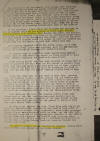
|
2.
14 April 1931.
Operations of Marine Corps planes from
Managua on East Coast during bandit
activities April 12-14,
Major R. J.
Mitchell, Managua, p. 2.
"[...]The morning
of the thirteenth, both planes left the
field at Pueto Cabezas 0940 and headed
straight for Moss farm where contact was
to be made with Capt. Wood, G.N., and
his patrol. Upon reaching Moss farm,
nothing could be seen of Wood, so the
planes split, Lieut. Jack heading north
in the direction of Logtown and Lieut .
Young in the opposite diection. Young
found Wood and his outfit, which
included Darrah and hs patrol, about
five miles south of Moss farm. Young
proceeded to escort Wood as far as the
latter place. Wood’s train could not go
any farther because of a burning
trestle—more work of the bandits. ¶ In
the meantime, Lieut. Jack had followed
the railroad as far as Logtown where he
saw a group of about eight bandits
loading horses with bundles. Upon seeing
the plane, the bandits dispersed, a few
running into some of the remaining
houses- had been burned to the
ground-and the others into the
surrounding brush. Jack dropped bombs
and opened up with his machine gun
immediately but was unable to tell what
effect they had. ¶ After having expended
all of his bombs, Lieut. Jack flew back
to where Lieut. Young was circling, gave
the information signal and returned to
Logtown with Young following. ¶ No
bandits were in sight but about
twenty-five saddled horses could be seen
wandering about, so Young decided to
kill these, thereby hampering the
bandits to some extent. ¶ After having
killed two the idea occurred to Young
that it might be possible for Capt Wood
and his patrol to capture these well
equipped animals and make good use of
them, especially in view of the fact
that it would be necessary for Wood to
hike all the way from the burned trestle
at Moss farm to Logtown. ¶ Young then
flew over to Capt Wood at Moss farm,
leaving Jack over Logtown to keep a
sharp lookout for any bandits who might
try to leave the vicinity, and made a
drop to Wood describing the situation
and advising a forced march to Logtown,
one plane to guard him all the way and
the other to keep a lookout at Logtown.
Young then returned to Logtown to carry
out the latter mission while Jack went
back to Wood and stayed with him until
he entered Logtown, an hour and
three-quarters later. ¶ Upon entering
the town, the Guardia patrol found that
things were as they had been
surmised-some bandits were in houses and
others on the outskirts of the town
hiding in the brush and apparently
waiting for the planes to leave so that
they might regain their horses. ¶ As the
patrol entered the town, Young flew very
low in an effort to determine the
location of the bandits from puffs of
smoke, from their rifles. They
apparently, were using smokeless powder,
for no smoke whatever could be seen, and
the only indication that Young had of
the approximate location of the bandits
was the direction in which he Guardia
were pointing their rifles. From this,
it was possible to estimate the location
of the bandits and Young dropped bombs
at where he thought the bandits were
hidden. ¶ The ground contact lasted
thirty-five minutes, during which eight
bandits were killed and two known
wounded.[...]"
|
|
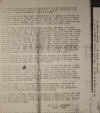
|
3.
14 April 1931.
Operations of Marine Corps planes from
Managua on East Coast during bandit
activities April 12-14,
Major R. J.
Mitchell, Managua, p. 3.
"[...] Seeing
that Capt Wood and his patrol had the
situation well in hand, and the gas
running low in the planes, Young and
Jack returned to Puerto Cabezas landing
at 1415. ¶ Later on that same day,
information of a group of bandits on the
railroad about twenty miles from Puerto
Cabezas was received and the planes took
off again at 1750 and patrolled until
1820, during which a message for Lieut.
Benson at Guardia Headquarters, Puerto
Cabezas, was dropped to a Mr. Lehman at
Wawa Boom. ¶ At five o’clock the
following morning, Tuesday 14 April,
Lieut. Young received a phone call from
Lieut. Benson, requesting a plane patrol
at once in the immediate vicinity of
Puerto Cabezas, word having been
received that the bandits were very
close. Young dressed immediately and
hurried to Guardia headquarters where he
met Lieut . Jack. Benson, in the
meanwhile, had gone down to the steamer
dock and did not return until about
0630. Upon reaching Headquarters, he
told Young and Jack that he had talked
with Capt. Wood by phone. The latter was
then at Wawa Boom with an engine, a
couple of flat cars and a box car.
Benson wrote a message for Wood, which
he turned over to Young with a request
that it be dropped to Wood. Benson also
stated that Wood had a message for him
and asked that it be picked up by one of
the planes. ¶ Both planes took off from
Puerto Cabezas at 0720 and flew along
the railroad to Wawa Boom, where Capt
Wood and his patrol were located. On the
way a railroad trestle about fifteen
miles out of Puerto Cabezas was found in
flames. ¶ Benson’s note was dropped to
Capt Wood and the latter’s message was
successfully picked up. In his message
Capt Wood stated he would return to
Puerto Cabezas with his patrol in a
motor launch, which was then tied up at
the dock at Wawa Boom. The planes then
returned to Puerto Cabezas without
having seen any bandits, although their
possible location was denoted by the
trestle as being approximately fifteen
miles from Puerto Cabezas. The planes
landed at 0810. ¶ The crews of the
planes then had breakfast, after which
Lieuts. Young and jack went aboard the
Asheville to call on Comdr. Waddell and
give him a clear estimate of the
situation while the mechanics serviced
the two planes. ¶ Comdr. Waddell
prepared a report for Admiral Smith and
turned it over to Lieut. Young for
delivery. Immediately after this, the
pilots went out to the flying field,
warmed up their planes, and took off at
155 for Managua, arriving there at 1440
after an uneventul flight. ¶ /s/ R. J.
MITCHELL, ¶ Major, USMC."
|
|
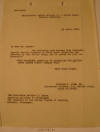
|
14 April
1931.
Message from Lt.
Col. W. C. Wise, Jr., Managua, to
US Minister Matthew E. Hanna, US
Legation, Managua.
"The following
code message from Commander, Special
Service Squadron to Chief Naval
Operations was received by this office
today, and is quoted for your
information: "0014 RECOMMEND ASHEVILLE
BE AUTHORIZED PUT LANDING FORCE ASHORE
PUERTO CABEZAS 0415""
|
|
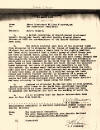
|
15 April
1931.
Patrol Report,
Lt. W. W. Benson, Puerto Cabezas,
to Col. John Marston, Bluefields.
"15 April 1931 ¶
From: First Lieutenant William W Benson,
GN. ¶ To: The Department Commander. ¶
Subject: Patrol Report. ¶ 1. A patrol
consisting of myself, Second Lieutenant
Leonard Cursey, and twenty enlisted
Guardia cleared Puerto Cabezas at 0630
for reconnaissance of the Puerto
Cabezas—Wawa boom Area. ¶ 2. The patrol
searched each side of the railroad track
from Kilometer 1 to Kilometer 26 for
traces of bandits. At Kilometer 19,
where the railroad makes a sharp turn to
the right, a position was found which
indicated that a bandit group of about
twenty men had been in ambush there.
Along the top of the bank to the left
grooves had been cut and outlines of
prone men were found. Decayed food,
cigarette butts, imprints of new
rubber-soled and hob-nailed shoes, such
as were included in the loots from the
robbed commissary were found at this
place. A freshly cut trail through the
adjacent brush indicated the route of
approach and departure to and from this
ambush. The various small Indian
settlements along the railroad line were
searched and found deserted, but no
damage appeared to have been done. At
Kilometer 21 a railroad bridge had been
burned and traffic blocked hereby. At
Kilometer 26 a group, of about 75mIndian
refugees was met on the railroad track.
These people had left Kipla, Plato, and
other farms in the Vance District and
were returning to their homes along the
coast. ¶ 3. Indians at Kilometer 24, who
had come in from Ayupini Sissin and
other towns to the North were questioned
regarding bandit activities in those
localities. Bandit groups had been in
Auyupini and Sisin, but had left on the
morning of April 14. ¶ 4. It is believed
that the Puerto Cabezas-Wawa Boom Area
is free from Bandits. ¶ (signed) W. W.
BENSON"
|
|
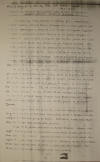
|
15 April
1931.
Extract from Reports from Eastern Area
Regarding Operations Against Bandits:
(Death of Blandon),"
no author,
summary of events near Puerto Cabezas,
April 11-15, 1931, p. 1.
|
|
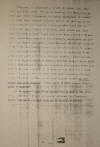
|
15 April
1931.
Extract from Reports from Eastern Area
Regarding Operations Against Bandits:
(Death of Blandon),"
no author,
summary of events near Puerto Cabezas,
April 11-15, 1931, p. 2.
|
|
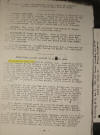
|
16 April
1931.
"Operations Against Bandits in Eastern
Area," Guardia
Nacional Newsletter No. 44, pp.
17-18, p. 1.
"OPERATIONS
AGAINST BANDITS IN EASTERN AREA. ¶ On
April 11, 1931, Captain H. Pefley, G.N.,
commanding Puerto Cabezas, cleared
Puerto Cabezas with a small guardia
patrol to investigate rumor of some
trouble at Logtown (approximately 60
miles from Puerto Cabezas on the Lumber
Company’s railroad). Upon arrival at
Logtown the Guardia patrol was fired at
and Captain Pefley was killed and one
guardia wounded. The Guardia patrol
fought off the assailants and drove them
in the direction of the Coco River.
Captain Pefley’s body was recovered and
taken to Puerto Cabezas, Lieut. Darrah
and Puerto Cabezas guardia patrol then
cleared in pursuit. Another guardia
patrol cleared at night to assist. ¶ On
April 12, it was reported that Lieut.
Darrah and his patrol were surrounded at
Moss Farm, south of Logtown, after all
night fight with armed outlaws of
unknown number and identity but
apparently well armed with plentiful
supply of ammunition. No Guardia
casualties. The U.S.S. Asheville was
ordered to proceed to Puerto Cabezas.
Marine planes cleared Managua to assist.
Captain Wood arrived Puerto Cabezas from
Bluefield and cleared with Lieut. Simmer
and guardia patrol to reinforce Darrah.
¶ Last report received April 12
indicated Darrah with patrol in good
condition at Wakinwas interposing
himself between Puerto Cabezas and
Blandon group at Snaki. Definitely known
tht Blandon with 75 men well armed were
present. ¶ On April 13 planes returned
Puerto Cabezas. Report that Captain
Wood’s patrol was escorted across Saki
bridge and found Moss Farm bridge
burned. Guardia marched to Cuyutigny
where they captured supply train from
bandits. Contact lasted 35 minutes.
Known dead bandits left on field eight
and 2 wounded. One guardia slightly
wounded. The following message was
received after the contact: [...]"
|
|
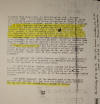
|
16 April
1931.
"Operations Against Bandits in Eastern
Area," Guardia
Nacional Newsletter No. 44, pp.
17-18, p. 2.
"[...] Telegram
from Bluefields, to jefe Director, GN.,
Managua. April 15, 1931. “Following
received from Wood quote My 18413 Apr
correction scratch out Pedron Altamirano
to correct error over long distance
telephone period The Jefe killed at
Logtown was in neat complete uniform
puttees black and red neckerchief rather
short stature under middle age black
pompadour hair squarely built body armed
with a forty five and broad bladed sword
period I took following papers from his
person colon one typewritten letter
dated February twenty one addressed to
Senor General Blandon entreating and
ordering him to report to Headquarters
comma one typewritten quote Credencial
de Representante personal de esa
Jefatura Suprema a favor del hermano
Jefe Expedicionario de Nuestro Ejercito
General Pedro Blandon en jira militar a
nuestra costa Atlantica unquote dated
sixteen March both signed A.C. Sandino
and his seal and obvious originals
period Also one order with Pedro
Blandon’s official signature period
Natives in vicinity Logtown stated the
jefe killed was Pedro Blandon- 08015
April 31 Wood unquote 09015 April 31
MARSTON.” ¶ It is apparent that Pedro
Blandon was killed in the contact.
Lieut. Benson and patrol returned from
Wawaboom-Puerto Cabezas region and
reported no bandit activities. ¶ On
April 16 Lieut. Darrah, Lieut. Curcey
and Puerto Cabezas Guardia patrol cleard
Puerto Cabezas for New Vance Tract to
disperse 60 local robbers, armed with
pistols and machetes. Patrol returned on
April 17 with 18 of the group and
considerable plunder. ¶ The first
Sergeant of the Guardia post at Neptune
Mine reported the capture of a spy from
the Blandon group and that the spy was
shot and killed while trying to escape.
THE END"
|
|
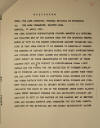
|
17 April
1931.
Radiogram from
Gen. C. B. Matthews, Jefe
Director GN, Managua, to Col. Marston,
Bluefields, p. 1.
"RADIOGRAM ¶ FROM
: THE JEFE DIRECTOR, GUARDIA NACIONAL DE
NICARGUA ¶ TO: THE AREA COMMANDER,
EASTERN AREA. ¶ MANAGUA, 17 APRIL 1931.
¶ THE JEFE DIECTOR CONGRATULATES COLONEL
MARSTON ALL OFFICERS AND ENLISTED MEN OF
THE EASTERN AREA FOR THE SPLENDID
PERFORMANCE OF DUTY IN THE RECENT
OPERATIONS AGAINST ORGANIZED BANDITS IN
THAT AREA PERIOD IT IS DESIRED TO
ESPECIALLY COMMEND THE MEMBERS OF
CAPTAIN PEFLEYS PATROL FOR THEIR
AGGRESSIVENESS AND COURAGE AFTER THEIR
LEADER HAD BECOME A CASUALTY AND FOR
THEIR ESPRIT DE CORPS DEMONSRATED BY THE
RECOVERY OF THEIR LEADERS BODY AND ITS
CONDUIT TO PUERTO CABEZAS COMMA LIEUT
DARRAH AND HIS PATROL FOR THE EXHIBITION
OF COURAGE DISPLAYED IN PURSUING AND
ENGAGING A FORCE SO MUCH LARGER THAN
THEIR OWN AND LATER THEIR WORK IN
CAPTURING LOCAL ROBBERS AND PLUNDER
COMMA CAPTAIN WOOD FOR HIS ENERGY SKILL
COURAGE AND JUDGMENT WHICH ENABLED HIM
TO INFLICT SEVERE LOSSES ON THE BANDITS
INCLUDING THE DEATH OF ONE OF THE
FOREMOST JEFES PEDRON BLANDON COMMA
FIRST SERGEANT PERRERA FOR HIS
INITIATIVE JUDGMENT AND DEVOTION TO DUTY
IN THE CAPTURE OF THE BLANDON SPY AT
NEPTUNE MINE AND COLONEL MARSTON AREA
COMMANDER FOR HIS COOL CAREFUL HANDLING
OF THE SITUATION AND THE HIGHLY
SATISFACTORY MANNER [...]"
|
|

|
17 April
1931.
Radiogram from
Gen. C. B. Matthews, Jefe
Director GN, Managua, to Col. Marston,
Bluefields, p. 2.
"[...] -2- ¶ IN
WHICH HE EMPLOYED HIS COMMAND DURING THE
TENSE AND THREATENING SITUATION PERIOD
IT IS DIRECED THAT THE AREA COMMANDER
PUBLISH THIS DISPTATCH TO THE ENTIRE
COMMAND AND CIRCULATE TO ALL MEMBERS THE
JEFE DIRECTORS PERSONAL AS WELL AS
OFFICIAL APPRECIATION FOR THEIR
EXCELLENT SERVICES PERIOD 15317 APRIL 31
¶ MATTHEWS"
|
|
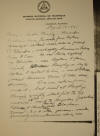
|
17 April
1931.
Memo from Capt.
J. C. Wood, Bluefields, to Col.
John Marston, Bluefields, p. 1.
Re mandador
Louisiana Farm Austin Murphy.
|
|
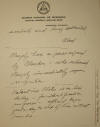
|
17 April
1931.
Memo from Capt.
J. C. Wood, Bluefields, to Col.
John Marston, Bluefields, p. 2.
Re mandador
Louisiana Farm Austin Murphy.
|
|
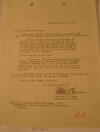
|
19 April
1931.
Memo from Matthew
E. Hanna, American Minister
Managua, to Gen. Calvin Matthews, Jefe
Director GN, Managua.
"Managua, April
19, 1931 ¶ My dear General Matthews: ¶ I
have just received the following
telegram dated April 18 from the German
Charge d’Affaires in Guatemala city: ¶
“German Consul Bluefields telegraphs 20
Germans are in risk of life today in
Puerto Cabezas German missionary was
killed yesterday in Department
Prinzapolka Permit me to appeal to your
humanitarian sentiments requesting of
you possible military aid in favor
countrymen in danger Sincere thanks.” ¶
I have replied as follows: “I have your
telegram concerning the alleged dangers
threatening a number of german citizens
in Puerto Cabezas and I will bring the
matter immediately to the attention of
the appropriate authorities here and
inform them of your request for aid.” ¶
I am bringing this to your attention in
fulfillment of statement made in my
foregoing telegram. ¶ I am, my dear
General Matthews, ¶ Sincerely yours,
(signed) Matthew E. Hanna ¶ American
Minister. ¶ Brigadier General Calvin
Matthews, G.N., ¶ Commanding Guardia
Nacional of Nicaragua, ¶ Managua"
|
|
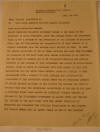
|
1.
20 April 1931.
Radiogram from
Henry L. Stimson, Washington DC.,
to M. E. Hanna, US Legation Managua, p.
1.
"US NAVAL
COMMUNICATION SERVICE ¶ MANAGUA
NICARAGUA APRIL 20 1931 ¶ FROM: STIMSON
WASHINGTON DC ¶ TO GOVT STATE AMERICAN
LEGATION MANAGUA NICAARAGUA ¶ GOVT STATE
AMLEGATION MANAGUA ¶ NINETY TWENTIETH
FOLLOWING STATEMENT ISSUED TO THE PRESS
BY THE SECRETARY ON APRIL EIGHTEENTH
QUOTE THE PROBLEM BEFORE THE GOVERNMENT
TODAY IS NOT A PROBLEM OF THE PROTECTION
OF ITS CITIZENS IN NICARAGUA FROM A WAR
BUT FROM MURDER AND ASSASSINATION IN
THAT RESPECT IT IS TOTALLY DIFFERENT
FROM THE PROBLEM WHICH EXISTED IN 1926.
IN 1926 TWO ARMIES CONSISTING OF TWO OR
THREE THOUSAND MEN EACH WERE FIGHTING IN
NICARAGUA ON THE EAST COAST BOTH ARMIES
PROFESSED TO BE CARRYING OUT THE RULES
OF WARFARE AND TO BE PROTECTING NEUTRALS
AND NEUTRAL PROPERTY SO THE PROBLEM OF
THIS GOVERNMENT WAS SOLVED BY
ESTABLISHING NEUTRAL ZONES IN WHICH BY
AGREEMENT WITH BOTH ARMIES AT THAT TIME
HOSTILITES DID NOT ENTER THESE NEUTRAL
ZONES AS I RECALL IT WERE ESTABLISHED
WITH A CONSENT OF BOTH LIBERALS AND
CONSERVATIVES COMMANDERS OF THE
CONTENDING ARMIES THERE WAS NO ORGANIZED
ATTEMPT TO MURDER PRIVATE CITIZENS OF
ANY COUNTRY THE PROBLEM WAS ONLY TO
PROTEC THEM FROM THE INEVITABLE
CATASTROPHE OF THE WAR WE NOW HAVE
SITUATION WHERE SMALL GROUPS OF
CONFESSED OUTLAWS TREATED AS OUTLAWS BY
THE NICARAGUAN GOVERNMENT ON MAKING
THEIR WAY THROUGH THE JUNGLES TO THE
EAST COAST WITH THE AVOWED INTENTION OF
MURDERING AND PILLAGING THE CIVILIAN
INHABITANTS OF THE COUNTRY THE TERRAIN
WHERE THIS IS TAKING PLACE IS ONE OF THE
THICKEST [...]"
|
|
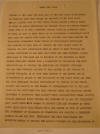
|
2.
20 April 1931.
Radiogram from
Sec. State Henry L. Stimson,
Washington DC., to M. E. Hanna, US
Legation Managua, p. 2.
"[...] SHEET TWO
CONTD ¶ JUNGLES IN THE WORLD THE RAIN
FALL IN THE EAST COAST OF NICARAGUA IS
SOMETHING MORE THAN DOUBLE THE RAINFALL
ON THE WEST COAST AND AS A RESULT THIS
IS VERY THICK JUNGLE COUNTRY A REGION
WHERE IT WOLD BE ALMOST IMPOSSIBLE FOR
REGULAR TROOPS TO OPERATE EFFECTIVELY
EVEN IF IT WERE ATTEMPTED ANOTHER POINT
OF DIFFERENCE WHICH IS VITAL AS THAT IN
1926 THERE WAS NO NICARAGUA CONSTABULARY
SINCE THAT TIME FOR NEARLY FOUR YEARS
OUR OFFICERS HAVE BEEN HELPING THE
NICARAGUAN GOVERNMENT TRAIN FORCES OF
CONSTABULARY ESPECIALLY FOR FIGHTING IN
THIS KIND OF TERRAIN THE VERY OBJECT
BEING TO PRODUCE THE MOST APPROPRIATE
KIND OF FORCE TO MEET TROPICAL AND
JUNGLE CONDITIONS OF WAR FARE THAT FORCE
HAS BEEN RECENTLY RAISED FROM 1850 TO
OVER 2100 AND IS REPORTED BY ITS
OFFICERS AS BEING HIGHLY EFFICIENT
PURELY FROM A STANDPOINT OF PROTECTION
THE MOST EFFECTIVE WAS TO PROTECT THE
AMERICANS AND FOREIGN CIVILIANS WHO HAD
BEEN SUDDENLY EXPOSED TO THIS DANGER IN
THE FORESTS OF EASTERN NICARGUA IS TO
GIVE THEM WARNING OF THE DANGER AND AN
OPPORTUNITY TO ESCAPE TO THE PROTECTION
OF THE COAST TOWNS AND THEN FOR THIS
SPECIALLY TRAINED CONSTABULARY TO
OPERATE IN THE JUNGLE AGAINST THE
BANDITS IF THE NUMBER OF CONSTABULARY
NOW ON THE EAST COAST IS NOT SUFFICIENT
FOR THAT PURPOSE THERE ARE CERTAINLY
ENOUGH ELSEWHERE TO REINFORCE THEM
AGAINST THESE COMPARATIVELY SMALL
BANDITS OUTLAWS AMERICAN NAVAL VESSELS
ARE STANDING BY AT ALL THE THREATENED
EAST COAST PORTS WITH ORDERS TO PROTECT
LIFE AND PROPERTY AT THESE PORTS THESE
SHIPS WILL REMAIN UNTIL THE DANGER IS
OVER BY ASSSISTING THE GOVERNMENT OF
NICARGUA IN ORGANIZING AND TRAINING A
COMPETENT GUARDIA WE ARE NOT ONLY
FURNISHING THE MOST PRACTICABLE AND
EFFECTIVE METHOD OF MEETING THE BANDIT
PROBLEMS AND THE PROTECTION OF [...]"
|
|
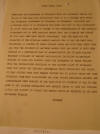
|
3.
20 April 1931.
Radiogram from
Sec. State Henry L. Stimson,
Washington DC., to M. E. Hanna, US
Legation Managua, p. 3.
"[...] SHEET
THREE CONTD ¶ AMERICANS AND FOREIGNERS
IN NICARAGUA FROM ITS ATTENDANT PERILS
BUT WE ARE AT THE SAME TIME RECOGNIZING
THAT IT IS A PROBLEM WITH WHICH THE
SOVEREIGN GOVERNMENT OF NICARAGUA IS
PRIMARILY CONCERNED AND A PROBLEM WHICH
IT IS PRIMARILY THE RIGHT DUTY OF THAT
GOVERNMENT TO SOLVE THERE HAS BEEN NO
CHANGE IN THE DETERMINATION OF THE
AMERICAN GOVERNMENT NOT TO SEND AMERICAN
TROOPS INTO THE INTERIOR THE EVENTS OF
THIS LAST WEEK HAVE PRETTY THOROUGHLY
TORN THE MASK OFF THE CHARACTER OF THE
MYTHICAL PATRIOT SANDINO TWO OF HIS LTS
HAVE BEEN RECOGNIZED AS LEADERS OF THESE
OUTLAWS BANDS AND BOTH FROM THEIR WORK
AND FROM THE EVIDENCE OF CAPTURED PAPERS
THEY ARE SHOWN TO HAVE BEEN ENGAGED IN A
DELIBERATE PLAN OF ASSASSINATION AND
PILLAGE AGAINST HELPLESS CIVILIANS OF
VARIOUS NATIONALITIES INCLUDING
NICARAGUANS WORKING IN MINES AND LOGGING
CAMPS THE MOVEMENTS OF THESE OUTLAWS
FROM THE NORTHWESTERN PROVINCES TO THE
EASTERN COAST OF NICARAGUA CAME JUST
AFTER THE TERRIFIC EARTHQUAKE WHICH
PROSTRATED THE CENTER OF THAT COUNTRY
WHEN EVER HUMANE IMPULSE WAS TO ASSIST
THOSE WHO WERE SUFFFERING FROM THAT
CATASTROPHE AND WHEN FORCES INCLUDING
MARINES AND CONSTABULARY WERE ENGAGED IN
THE ELEVATION OF DISTRESS IT WAS IN THE
HOUR OF HIS COUNTRY DESOLATION AND
SANDINO CHOSE TO SEND HIS OUTLAWS ACROSS
THE COUNTRY TO ATTACK THE REGION WHICH
HE BELIEVED TO BE LEFT UNGUARDED UNQUOTE
¶ STIMSON"
|
|

|
1.
20 April 1931.
Assistance by the US Marines in the
Suppression of Bandit Activities in
Nicaragua.
Sec. State Henry
Stimson (Wash DC), American Minister
Matthew Hanna (Managua), Vice Consul
Rowe (Bluefields), various
telegrams, p. 1.
Papers Relating to the
Foreign Relations of the United States,
1931, vol. 2 (Wash DC: GPO, 1946),
pp. 804-05.
13 April
(1500) telegram Rowe to Stimson.
14 April (1500) telegram Hanna to
Stimson (pt 1).
|
|

|
2.
20 April 1931.
Assistance by the US Marines in the
Suppression of Bandit Activities in
Nicaragua.
Sec. State Henry
Stimson (Wash DC), American Minister
Matthew Hanna (Managua), Vice Consul
Rowe (Bluefields), various
telegrams, p. 2.
Papers Relating to the
Foreign Relations of the United States,
1931, vol. 2 (Wash DC: GPO, 1946),
pp. 806-07.
•
14 April (1500) telegram Hanna to
Stimson (pt 2).
• 14 April (2000) telegram
Stimson to Hanna.
•
16 April (1800) telegram Stimson
to Hanna (pt 1)
|
|

|
3.
20 April 1931.
Assistance by the US Marines in the
Suppression of Bandit Activities in
Nicaragua.
Sec. State Henry
Stimson (Wash DC), American Minister
Matthew Hanna (Managua), Vice Consul
Rowe (Bluefields), various
telegrams, p. 3.
Papers Relating to the
Foreign Relations of the United States,
1931, vol. 2 (Wash DC: GPO, 1946),
pp. 808-09.
•
16 April (1800) telegram Stimson
to Hanna (pt 2)
•
16 April (1900) telegram Stimson
to Hanna.
"In view of outbreak of banditry in
portions of Nicaragua hitherto free from
such violence you will advise American
citizens that this Government cannot
undertake general protection of
Americans throughout that country with
American forces. To do so would lead to
difficulties and commitments which this
Government does not propose to
undertake. Therefore, the Department
recommends to all Americans who do not
feel secure under the protection
afforded them by the Nicaraguan
Government through the Nicaraguan
National Guard to withdraw from the
country, or at leas to the coast towns
whence they can be protected or
evacuated in case of necessity. Those
who remain do so at their own risk and
must not expect American forces to be
sent inland to their aid."
•
17 April (1800) telegram Rowe to
Stimson
•
17 April (2000) telegram Hanna to
Stimson (pt 1)
|
|

|
4.
20 April 1931.
Assistance by the US Marines in the
Suppression of Bandit Activities in
Nicaragua.
Sec. State Henry
Stimson (Wash DC), American Minister
Matthew Hanna (Managua), Vice Consul
Rowe (Bluefields), various
telegrams, p. 4.
Papers Relating to the
Foreign Relations of the United States,
1931, vol. 2 (Wash DC: GPO, 1946),
pp. 810-11.
•
17 April (2000) telegram Hanna to
Stimson (pt 2)
• 17 April (2200) telegram
Hanna to Stimson (pt 1)
|
|

|
5.
20 April 1931.
Assistance by the US Marines in the
Suppression of Bandit Activities in
Nicaragua.
Sec. State Henry
Stimson (Wash DC), American Minister
Matthew Hanna (Managua), Vice Consul
Rowe (Bluefields), various
telegrams, p. 5.
Papers Relating to the
Foreign Relations of the United States,
1931, vol. 2 (Wash DC: GPO, 1946),
pp. 812-813.
• 17
April (2200) telegram Hanna to Stimson
(pt 2)
• 18 April (1400) telegram
Stimson to Rowe
•
18 April (1500) telegram Stimson
to Hanna
• 18
April (1600) telegram Rowe to Stimson
• 19 April (2000) telegram
Hanna to Stimson (pt 1)
|
|

|
6.
20 April 1931.
Assistance by the US Marines in the
Suppression of Bandit Activities in
Nicaragua.
Sec. State Henry
Stimson (Wash DC), American Minister
Matthew Hanna (Managua), Vice Consul
Rowe (Bluefields), various
telegrams, p. 6.
Papers Relating to
the Foreign Relations of the United
States, 1931, vol. 2 (Wash DC: GPO,
1946), pp. 814-15.
•
19 April (2000) telegram Hanna to
Stimson (pt 2)
• 20 April (1300) telegram
Stimson to Hanna
• 20 April letter Stimson to
Hanna with press statement (first part)
|
|
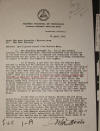
|
21 April
1931.
Intelligence Report from Neptune Mine.
Col. John
Marston, Bluefields, to Jefe
Director GN.
|
|
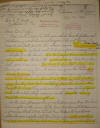
|
1.
22 April 1931.
Letter from
Elizabeth Bregenzer, Tuburus on
the Wawa River, to Dr. S. H. Gapp,
Bethlehem PA, p. 1.
"Dr. S. H. Gapp ¶
Bethlehem, Pa. ¶ Dear Bro. Gapp: ¶ How
shall I begin to tell you what has
befallen us! Whether any word has
reached you I do not know. On Mar. 31st
about 10 AM the alarm came “The
Spaniards are coming” and in haste each
took up a few necessary things and
started for the bush. Br. Bregenzer
however would not go with us. He had the
assurance of Heb. 13:6 and his last word
to me was: “The Lord God is still
alive”. We then made our way to a hidden
camp in the bush previously prepared for
just such an emergency, and later some
of Sumu men found us and took us still
further away for they had been watching
from the bush and they thought it wiser.
They said our house was full of
Spaniards and the whole village overrun
with bandits, many Miskitos and Sumus
among them. ¶ In the late afternoon one
of our helpers came to us. He had been
caught on the river by the bandits and
brought to Musawas a prisoner. About 2
PM he had been taken to our house where
he saw and spoke with Br. Bregenzer, who
was tied on one arm and being led around
by a guard while the . . . "
|
|
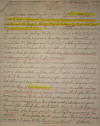
|
2.
22 April 1931.
Letter from
Elizabeth Bregenzer, Tuburus on
the Wawa River, to Dr. S. H. Gapp,
Bethlehem PA, p. 2.
". . . bandits
were spoiling our goods. In his free
left hand he had a Spanish New Testament
from which he read and proclaimed the
Gospel though they told him to keep
still for they didn’t want to hear. Then
this helper (Everesto) who was prisoner
was given a machete (a huge knife) in
his hand and told to kill Br. B. with it
but he refused and then they said –
“alright then you must die too for you
are his friend” and taking him outside
they would have done so but were taken
by surprise when he made a dash for
freedom and though they threw knives and
shot pistols and guns after him he got
away safely. ¶ We slept in the open that
night and next day went still deeper
into the bush and there in the evening
another helper found us bringing news of
what was taking place. When I asked him
what news of Br. B. he answered:
“Yesterday afternoon they buried him”.
Not till several days later did we find
out facts and they are not in detail for
those of our Sumus who remained in the
village were not allowed to come near.
It seems that after the man Everesto
escaped, the bandits tied another rope
around Br. B’s other arm and dragged him
to a place just outside our yard fence –
(the site of the old toilet!). Here he
knelt to pray and they asked “who do you
pray to--to Holy Mary or one of the
saints?” It is reported Br. B. answered:
“No, I am not made of wood—I pray to the
Lord Jesus Christ”. At this they . . . "
|
|
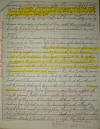
|
3.
22 April 1931.
Letter from
Elizabeth Bregenzer, Tuburus on
the Wawa River, to Dr. S. H. Gapp,
Bethlehem PA, p. 3.
". . . became
very angry and slashed at him with their
machetes and finally beheaded him and
buried him in a shallow 4 inch grave. ¶
This band of men consisted of 250 men at
sundown another band of 300 arrived. Two
weeks before the captain of this last
band had sent 3 spies to Musawas and
they had learned from our Sumus of our
hiding supplies in a secret place in the
bush and had also heard a lot of vile,
malicious lies spoken against Br. B. by
those who opposed the preaching of the
Gospel in Musawas and this band came
with the intention of freeing our Sumus
from the tyranny of such an evil man as
they had heard the parson to be, but
they came too late. But the things
hidden in the bush would have escaped
but knowing about them they set out to
search, looking 2 days without success
and then a Musawas Sumu led the way. A
box of medicine was literally emptied
all over the ground, bottles broken and
pills, etc. covered the ground. Other
things they seem to have taken with
them. They were also looking for us to
kill us also. The Sumus left in the
village they tried to force to reveal
our hiding place. None of them actually
knew but on threat of death one man was
ready to tell but another told him
sternly to keep still, it was enough.
They told the people not . . .
[upside-down at the top of the page:]
"¶ The text that morning was John 15:13.
Br. B was much burdened with the soul
that were yet lost, and it was this that
kept him there to give the Gospel to the
bandits for how shall they hear without
a preacher! Rom. 1:16 was the text of
his first sermon in Blfds. And his motto
throughout his ministry . . . "
|
|
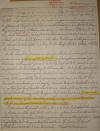
|
4.
22 April 1931.
Letter from
Elizabeth Bregenzer, Tuburus on
the Wawa River, to Dr. S. H. Gapp,
Bethlehem PA, p. 4.
". . . to tell
what became of the parson—he just simply
disappeared, and afterward they should
kill us with poison. On Good Friday they
were playing victrola and dancing in our
house and Saturday AM they left Musawas,
leaving 5 men behind as a sort of rear
guard and these set fire to the house
and all other buildings on the premises.
The church didn’t catch but they broke
the pulpit and vilely polluted the
building. ¶ In the meantime we were
camping in the bush and when we heard on
Easter Sunday of the complete
destruction of everything we realized
there was nothing left for us to do but
to try to get to the coast as soon as
possible. It is a long story to tell
everything but by the wonderful and
abundant mercies of our Lord and Saviour
we have come so far. Food, clothing and
shelter He has provided each day and we
trust that He will also lead us out
safely. Arrived here we heard that ahead
of us there had been trouble also and we
are waiting here for news from below
that the way will be open before we
proceed. I cannot speak enough of the
devotion, self sacrifice and
considerations which our Sumu carriers
have shown us. ¶ Please excuse the
pencil writing. It is a 2 inch stub
which I have quite by chance, or rather
by the Lord’s will and having time here
I write so that when by His help we
reach Bilwi you may receive this
speedily. Expect to go to Blfds,
D.V.—Beyond that I do not know. The Lord
will direct. With kind regards, I am,
Sincerely, Elizabeth Bregenzer [upside-down
at the top of the page:]
¶ Please do not give honor to my
husband, he would not be pleased for all
honor belong to our Lord and Savor Jesus
Christ."
|
|
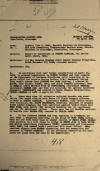
|
1.
22 April 1931.
Report of operations in PUERTO CABEZAS,
for period April 12-17, 1931.
Captain John C.
Wood, Bluefields, to Area
Commander Col. John Marston, Bluefields,
p. 1.
"HEADQUARTERS
EASTERN AREA ¶ Bluefields, Nicaragua ¶
GUARDIA NACIONAL ¶ 22 April 1931 ¶ From:
Captain John C. Wood, Guardia Nacional
de Nicaragua. ¶ To: The Area Commander,
Headquarters Eastern Area, Guardia
Nacional de Nicaragua, Bluefields,
Nicaragua. ¶ Subject: Report of
operations in PUERTO CABEZAS, for period
April 12-17, 1931. ¶ References: (a) Map
Showing Bragman Bluff Lumber Company
Properties, dated November 17, 1928,
attached hereto. ¶ Enclosures: (2). ¶ 1.
In accordance with your verbal
instructions of April 11, 1931, to
proceed immediately to PUERTO CABEZAS
and take command of the Department of
Northern Bluefields until reporting of
regular relief for Captain Harlan
Pefley, G.N., deceased, killed from
bandit ambush near LOGTOWN the same
morning, I cleared EL BLUFF, with
Captain RIDEN, (MC), and Ninth Company
personnel then on General Court Martial
duty in BLUEFIELDS, Lieutenant BENSON,
Lieutenant SIMMER (MC) and four (4)
enlisted, via special chartered
schooner, “ANDERSON”, and arrived at
Ninth Company Headquarters, PUERTO
CABEZAS, at 1450 on April 12, 1931. ¶ 2.
There were nine (9) effective enlisted
Guardia and about thirty (30) armed
civicos with three (3) Ninth Company
officers on duty in PUERTO CABEZAS.
Lieutenant DARRAH, with civico
volunteers assistant, Mr. RALPH
BEARDSLEY, Canadian, employee of Bragman
Bluff Lumber Company, was then operating
against bandit force near MOSS FARM,
with thirty (30) enlisted Guardia, one
(1) applicant, an one (1) additional
civico. There were two (2) Guardia
enlisted at Guardia Post TOLEDO WYN,
located in YARLIS FARM. ¶ 3. In the
forenoon DARRAH had been fighting to
extricate patrol from a dangerous
position, in the hills of MOSS FARM,
having been cut off from their base by
bandit control of SNAKI STEEL BRIDGE
from position on a hill close to bridge
on NORTH side of WAWA RIVER. Two Marine
amphibians, Lieutenant YOUNG,
commanding, and Lieutenant JACK, USMC,
had bombed bandit positions with great
effect. Today received signals from
DARRAH requesting food and ammunition
and returned to PUERTO CABEZAS. In the
afternoon ammunition was prepared for
plane drop and sent by the amphibians.
[...]"
|
|
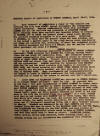
|
2.
22 April 1931.
Report of operations in PUERTO CABEZAS,
for period April 12-17, 1931.
Captain John C.
Wood, Bluefields, to Area
Commander Col. John Marston, Bluefields,
p. 2.
"[...] -2- ¶
SUBJECT: Report of operations in PUERTO
CABEZAS,April 12-17, 1931. ¶ 4. Upon
take-off of amphibians a rumor of “the
bandits are entering the city from
NORTH” spread throughout the townspeople
almost instantly. Boarded commandeered
truck with Lieutenant SIMMER and six (6)
enlisted and proceeded to AVIATION
FIELD. While boarding truck gave
explicit and repeated orders, to civicos
at CUARTEL not to sound the general
alarm – power plant whistle. The
northern boundary entrances to city were
quiet. Returning to CUARTEL , we found
that the general alarm had been sounded,
and it had caused a general panic in the
city, during which practically all women
and children ran, screaming, to wharf
and stampeded aboard the tourist
passenger and fruit S S CEFALU , and the
smaller utility labor passenger and
cargo S S WOUNTA. ¶ 5. In the late
afternoon amphibian BENSON observer
returned to PUERTO CABEZAS. Lieutenant
YOUNG reported that DARRAH was breaking
through bandit lines and had waved off
ammunition drop. Had telephone operator
attempt communication with several
mandador’s houses in vicinity SOUTH of
SNAKI STEEL BRIDGE. Finally obtained
communication with WAKIWAS FARM and
report from that place that DARRAH had
broken through and was approaching.
DARRAH reported via telephone from
WAKIWAS FARM that he had two brief
contacts with bandits in the vicinity of
MOSS FARM, had forced crossing over
SNAKI STEEL BRIDGE during which one
Guardia was seriously wounded, and that
they were now all in camp at WAKIWAS
FARM. Made arrangements and telephoned
authority for DARRAH to break in WAKIWAS
commissary for food supplies and
directed him to stand by for orders to
control next day’s operations. ¶ 6.
About 1750 one VALENTINE CLOTES was
reported in PUERTO CABEZAS as an escaped
Bandit prisoner. Sent for him. He
reported that he had been a very good
acquaintance of PEDRO BLANDON in former
years when they had worked together in
lumber business and carpenter trade,
near PUERTO CABEZAS , that he had been a
BLANDON prisoner at MOSS FARM for over
twelve (12) hours, and had escaped that
morning when planes bombed bandit camp,
and while bandits scurried for cover at
the command of the Jefe who directed
“take to a stump”—of a tree. CLOTES said
that he had talked with BLANDON two or
three times; that there were sixty well
armed men, two boys, who carried full
shoulder ammunition slings, two sakks
reserve ammunition, two (2) Lewis
machine guns, one (1) Winchester
repeating rifle, and a small “cannon”
mounted on wheels. BLANDON was overheard
to say that SANDINO and three hundred
fifty men were on route to the RAILROAD
LINE via PIS PIS TRAIL, and ALTAMIRANO
was coming via the COCO RIVER, and upon
arrival of both columns a concentrated
attack would be made on PUERTO CABEZAS,
and that they would take it “dead or
alive”. VALENTINE CLOTES, negro, mature,
fairly well educated, above laboring
class, is a serious citizen and his
information was considered very
reliable. [...]"
|
|
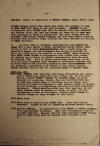
|
3.
22 April 1931.
Report of operations in PUERTO CABEZAS,
for period April 12-17, 1931.
Captain John C.
Wood, Bluefields, to Area
Commander Col. John Marston, Bluefields,
p. 3.
"[...] -3- ¶
SUBJECT : Report of operations in PUERTO
CABEZAS, April 12-17, 1931. ¶ CLOTES
further stated that there were sixty
(60) bandits in camp at MOSS FARM hill
where he was held prisoner. BLANDON in
his conversation with CLOTES said that
his entire force then numbered one
hundred fifty, and that the balance of
those not in camp were then operating in
bands of twenty-five (25) each, along
near the RAILROAD LINE towards PUERTO
CABEZAS, and that many bandit recruits
obtained from destitute farms laborers
had been obtained in vicinity of SNAKI
district. ¶ 7. At about 1900 in
telephone communication with DARRAH who
asked that a good supply of Krag,
Springfield and .38 pistol ammunition be
sent to him. (----) DARRAH that I would
bring the ammunition supply and
reinforcements and arrive at daylight on
April 13, 1931, and to be prepared to
move NORTH, force crossing over SNAKI
STEEL BRIDGE in conjunction with attack
from planes. Our mission was to drive
out bandit concentration from the head
of RAILROAD LINE. Part of these
instructions were given in the local
military telephone code, because of
previously reported ruse by which
bandits had elicited information from
non-combatants over the telephone,
pretending to be laborer of the Lumber
Company. DARRAH informed that he had cut
telephone NORTH of WAKIWAS FARM. ¶ APRIL
13, 1931. ¶ 0300 WOOD, SIMMER, four
enlisted, with Krag, Springfield and .38
cal. Pistol ammunition, armed with four
rifles, two .45 Colt automatics, cleared
PUERTO CABEZAS for WAKIWAS FARM, via
train composed of locomotive, tender,
flat car fortified with row of sand bags
around edges of platform and one banana
car. Instructed locomotive engineer to
make highest speed, no whistle or bell
warnings, no dispatching, and stop only
when absolutely necessary. Placed
gasoline motorcar, with operator, to run
three hundred yards in advance of train,
as point, to give forewarning in case of
derailment, torn-up track, damage to
trestle bridges or other attempt to stop
train. ¶ 0415 Water stop. ¶ 0545 Water
stop at Guardia Post TOLEDO WYN. Place
practically deserted. Picked up two (2)
remaining enlisted Guardia there. ¶ 0620
Arrived WAKIWAS. In communication with
BENSON at PUERTO CABEZAS , over long
distance telephone. Made las
arrangements relative to plane take-off.
Message received from Lieutenant YOUNG
saying that he would stick with the
Guardia until released by me. [...]"
|
|
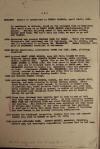
|
4.
22 April 1931.
Report of operations in PUERTO CABEZAS,
for period April 12-17, 1931.
Captain John C.
Wood, Bluefields, to Area
Commander Col. John Marston, Bluefields,
p. 4.
"[...] -4- ¶
SUBJECT: Report of operations in PUERTO
CABEZAS, April 12-17, 1931. ¶ In
readiness to entrain, stood by for
arranged time of departure that would
place us at SNAKI STEEL BRIDGE
simultaneously with planes. Guardia
enlisted asked if they wanted more
coffee, passed word back, ”We don’t want
any food; we want to go out and fight.”
¶ 0820 Entrained and cleared WAKIWAS
FARM for SNAKI. Three (3) officers,
thirty-six (36) enlisted, and one (1)
applicant, one (1) civico, and one (1)
assistant to officers, Mr. BEARDSLEY.
Total forty-two (42). List of personnel
contained in enclosure. ¶ 0920 Marine
amphibians, Lieutenants YOUNG and JACK,
USM, piloting, observed. ¶ 0945 Arrived
SNAKI STEEL BRIDGE, span 480 feet,
height 30 feet. Observed beyond MOSS
TRESTLE BRIDGE burning, smoke covering
entire right-of-way. Opened fire on two
(2) men lurking near SNAKI BRIDGE on
NORTH side, who took cover in brush
hill. One rail torn out of railroad
track on bridge at SOUTH END. Mr.
BEARSLEY started to repair it. Abandoned
train and proceeded on foot. Lieutenant
SIMMER, Mr. BEARDSLEY, and six (6)
enlisted, covered by machine gun and
rifle fire in readiness, crossed bridge
without drawing bandit fire. ¶ 1020 All
Guardia across bridge. ¶ 1030 Arrived
MOSS TRESTLE BRIDGE, wooden, 210 feet
span, height 25 ft., burning, and made
crossing in ravine fording stream. About
three hundred (300) yards beyond, in
vicinity of bandit camp of previous day,
found portable field telephone set, with
long wires attached and lying on ground,
in middle of railroad track. The
railroad line telephone wires were never
cut by bandits during the period. ¶ 1035
Plane drop informed that bandits were in
town at end of left hand spur where old
locomotive left. In this vicinity,
between MOSS FARM and LOUISIANA FARM saw
about fifteen bodies of natives and
negroes. Six headless bodies seen
sprawled out down banks of ravines near
bottom. It was later reported that
Americans W. Bond and P. Davis were
among these six. Dozens of buildings had
been burned to the ground, including
commissaries. ¶ 1130 Passed the
abandoned locomotive, tender, flat car,
and armored banana car, used by DARRAH
on April 11, 1931. ¶ 1140 Arrived
LOUISIANA FARM. AUSTIN MURPHY, mandador,
Canadian, mature age, and thoroughly
responsible, informed that he had been
[...]"
|
|
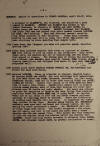
|
5.
22 April 1931.
Report of operations in PUERTO CABEZAS,
for period April 12-17, 1931.
Captain John C.
Wood, Bluefields, to Area
Commander Col. John Marston, Bluefields,
p. 5.
"[...] -5- ¶
SUBJECT: Report of operations in PUERTO
CABEZAS, April 12-17, 1931. ¶ ……a
prisoner of BLANDON’S , was released,
and exhibited pass signed by BLANDON.
MURPHY and BLANDON had worked in the
lumber business, in vicinity of PATUCA
and COCO RIVER, in former years and were
friends. MURPHY informed that BLANDON
and sixty(60) men had passed this point
headed towards LOGTOWN at 0500, that
morning. They had obtained several
recruits from farms laborers in that
vicinity. Plane drop informed bandits in
camp near hill in town, over which the
plane had been circling; 1-1/2 hours
gasoline fuel supply left. ¶ 1150 Plane
drop. Msg “Suggest you make all possible
speed. Gasoline getting low”. ¶ 1205
Plane drop informed bandits took cover
on approach of planes; and were trying
to fire up steam in old locomotive. Only
three bombs left, one machine gun out of
commission, and two hours fuel supply in
planes. The hiking pace of troops was
increased, and although some Guardia
were heavily loaded, HRMG tripod, gun,
reserve ammunition, and fatigued from
march in open sun, they responded well.
¶ 1230 Passed point where Captain HARLEN
PEFLEY, GN, was ambushed and killed two
days previously. ¶ 1235 Entered LOGTOWN.
Place is situated in cleared, shallow
basin, RR running NORTH and SOUTH. The
only buildings left undestroyed by fire
were about two dozen laborers, portable,
(on flat cars), abandoned shacks, laid
out in three rows running NORTH and
SOUTH, facing RR tracks. Bandit fire
opened on us from EAST and WEST rims of
basin, near brush. Immediately opened
fire on bandits running among shacks,
most of whom were dashing for cover near
ditches near RR tracks and under shacks.
Old negro man ordered to point out
positions of bandits who were firing
from elevated positions about 300 yards
WEST and 75 yards EAST. He replied “They
are on all sides of you” and ran SOUTH
towards railroad entrance to clearing
where we entered. There was difficulty
in holding back Guardia in one line. In
eagerness for combat they overran firing
line. Passing among shacks, Mr. BEARDLEY
suddenly came upon well uniformed and
dressed bandit, who was making for cover
underneath a shack. Mr. BEARDSLEY shot
him at close range with rifle. The
bandit staggered a few steps, was hit
again, and fell to his hands and knee
when a dozen Guardia saw him and opened
fire. This bandit was very tenacious of
life and expired only a few minutes
before the Guardia left LOGTOWN. After
clearing shacks extended in skirmish
line, NORTH-SOUTH ,and attacked toward
EAST, up gradual inclination to crest.
[...]"
|
|
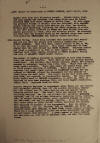
|
6.
22 April 1931.
Report of operations in PUERTO CABEZAS,
for period April 12-17, 1931.
Captain John C.
Wood, Bluefields, to Area
Commander Col. John Marston, Bluefields,
p. 6.
"[...] -6- ¶
SUBJECT: Report of operations in PUERTO
CABEZAS, April 12-17, 1931. ¶ Bandit
fire from this direction ceased. Turned
about, down, and past shacks and
reformed line along ditch near RR track.
Advanced WEST with short rushes of
entire line. At this stage the greatest
volume of Guardia fire was obtained,
with amphibian planes bombing and laying
down machine gun fire, two Guardia
machine guns operating, including the
heavy Browning in action on our left
flank, directed at enemy who were firing
from concealed positions in brush, near
our entering point. We advanced not more
than one hundred yards up the western
slope when bandit fire gradually
diminished and finally ceased entirely.
¶ 1310 Ceased firing. Plane drop
informed that gasoline fuel supply was
low and that the planes were clearing
immediately for PUERTO CABEZAS. Sent
four small combat patrols to NE, N, NW,
W, to find scattered bandits. Tall negro
inhabitant of town stated that the jefe
killed was PEDRO BLANDON. Searched
bodies and found a commission on body of
jefe signed by A C SANDINO, together
with other papers, directed to PEDRO
BLANDON, making him jefe of ATLANTIC
COAST bandit forces. ¶ The number of
bandits involved is estimated to have
been between sixty and seventy (60-70).
There were no dead or missing Guardia
casualties. One Guardia, Raso Rafael
Rosales, #2214, was slightly wounded in
abdominal region from rifle fire. There
were two (2) known bandit wounded. There
were eight (8) bandit dead, left on
field within clearing of LOGTOWN. There
was a total of eighteen (18) bandit dead
counted by VALENTINE CLOTES, who was
ordered to LOGTOWN, after the engagement
for the purpose of identifying the dead
jefe. His report stated that there were
more dead, not counted, in inaccessible
places. The total estimated bandit dead
in LOGTOWN ENGAGEMENT, on April 13,
1931, is reported to have been eighteen
(18), and total bandit casualties,
twenty (20). Captured bandits: None. ¶
Guardia weapons employed in engagement
were: Three (3) .45 calibre Colt
automatic pistols, four (4) .38 calibre
revolvers, thirty-four (34) rifles, one
(1) Lewis machine gun and one (1) heavy
Browning machine gun. The bandit force
was equipped with the following weapons:
Two (2) .45 calibre Colt automatic
pistols, captured, one (1) .44 calibre
Winchester repeating rifle, captured,
four (4) muzzle loading rifles, poor,
captured, damaged in action and
destroyed, and two (2) swords, captured.
It is my opinion that about forty to
fifty (40-50) rifles, revolvers and
pistols were employed by bandits in the
engagement. Four (4) mules, were
captured. One (1), wounded, left at
LOGTOWN, and three (3) captured mules
were returned to MOSS FARM, Lumber
Company property. There are a large
number of horses and mules maintained
and used in each banana farm district. A
great number of these animals are
scattered all over end of RAILROAD LINE,
and near the banana farms. [...]"
|
|
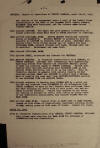
|
7.
22 April 1931.
Report of operations in PUERTO CABEZAS,
for period April 12-17, 1931.
Captain John C.
Wood, Bluefields, to Area
Commander Col. John Marston, Bluefields,
p. 7.
"[...] -7- ¶
SUBJECT: Report of operations at PUERTO
CABEZAS, April 12-17, 1931. ¶ The
results of the engagement were: A part
of the bandit force concentrated at the
head of the Bragman’s Bluff Lumber
Company RALROAD LINE were destroyed, and
the balance were driven towards SAKLIN.
1430 Cleared LOGTOWN. Old negro who gave
general information on bandit positions
found shot dead in SOUTH entrance to
clearing. ¶ 1520 Arrived LOUISIANA FARM.
AUSTIN MURPHY identified captured swords
as BLANDON’S. Ordered MURPHY to proceed
as soon as possible to LOGTOWN to
identify body of jefe. Informed that
shortly after rifle firing ceased one
(1) bandit ran past LOUISIANA FARM,
wounded through left hand, through neck
and in shoulder. Detachment had some
food. ¶ 1550 Cleared LOUISIANA FARM. ¶
1700 Arrived SNAKI, entrained and
cleared for WAKIWAS. ¶ 1640 Arrived
WAKIWAS. In telephone communication with
BENSON, at PUERTO CABEZAS. Informed that
townspeople were momentarily expecting
attack from bandits and requested
Guardia patrol to make all possible
speed to PUERTO CABEZAS. Warned that
bandits were reported operating near
RAILROAD LINE in the central farms
districts, and to be on the alert. This
information checked in general with
several reports we had received between
SNAKI and LOGTOWN to effect that a
detachment of bandits had been sent from
LOGTOWN-CUYUTIGNI section to the
RAILROAD LINE via AUAPINI TRAIL. ¶ 1930
Stopped suddenly at Guardia Post TOLEDO
WYE by a motor car boy who had returned
from KILOMETRE 13 (13 kilometres from
PUERTO CABEZAS) to warn us that bandits
were stationed there and were stopping
all motor cars at that point, and had
already arrested several. Placed four
guardia to clear track of any
obstruction encountered, and cleared
TOLEDO WYE for WAWA BOOM. ¶ 2010 Arrived
WAWA BOOM. Placed rain on EAST side of
WAWA BRIDGE, --swamp on both sides of
right-of-way, headlight covering entire
bridge, sentry posts at both ends of
grain. Camped for night. ¶ APRIL 14,
1931 ¶ 0730 In telephone communication
with BENSON, PUERTO CABEZAS. Informed
that planes were clearing for WAWA BOOM
for exchange of communications and
observations. [...]"
|
|
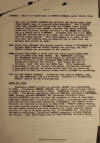
|
8.
22 April 1931.
Report of operations in PUERTO CABEZAS,
for period April 12-17, 1931.
Captain John C.
Wood, Bluefields, to Area
Commander Col. John Marston, Bluefields,
p. 8.
"[...] -8- ¶
SUBJECT : Report of operations at PUERTO
CABEZAS , April 12-17, 1931. ¶ The city
of PUERTO CABEZAS had suffered the
second panic from false bandit news of
invasion about midnight. For a second
time sick, wounded and dying from the
Bragman Bluff Lumber Company Hospital
were rushed, together with panic
stricken women and children, through the
city to the wharf and aboard the S S
CEFALU and S S WUANTA. Informed that the
U S S ASHEVILLE had arrived during the
night, but that her landing force was
not coming ashore. This gave origin to a
rumor in the city that the bandits were
so numerous and so near that the marines
were afraid to land. ¶ 0840 Plane drop
informed that wooden trestle bridge at
KILOMETER 23 between WAWA BOOM and
PUERTO CABEZAS was burning, and that
PUERTO CABEZAS was surrounded by the
bandits. ¶ 0940 Cleared WAWA BOOM on
forty foot sea going launch NORTH STAR
and proceeded down WAWA RIVER. Mr.
BEARDSLEY piloting. Mr. BEARDSLEY had
placed launch engine in operation after
great difficulty, after stripping WAWA
BOOM commissary of telephone batteries
for current. The launch was run on
battery. Lost life boat over WAWA BAR.
With inadequate knowledge of the bar,
except from meager information obtained
from Indian Guardia, we struck bottom
over the bar about one half mile at sea,
and several times nearly stranded by
grounding. ¶ 1215 Arrived PUERTO
CABEZAS. Conferred with Captain WADELL,
USN, CO, USS ASHEVILLE, and his
officers. Prepared for dispatching
combat patrol on the following day. ¶
APRIL 15, 1931. ¶ Lieutenant CURCEY
arrived on schooner LEONET from
BLUEFIELDS, at 0230. Lieutenant BENSON,
CURCEY, and twenty (20) enlisted cleared
on Combat mission, via train at 0630.
AHSEVILLE landing force ashore at 0930.
Two Marine amphibians, Captain JOHNSON,
Lieutenant SCHRIMKER , USMC, pilots,
Captain SCHWERIN, GN, passenger arrived
at 1140. Captain SCHWERIN reported for
duty and assigned to duty as Department
Commander, Department of Northern
Bluefields, in accordance with radiogram
instructions from Area Commander,
BLUEFIELDS, 1600 BENSON patrol returned
and reported no bandits in WAWA BOOM –
PUERTO CABEZAS region, but found trestle
bridge at KIOLMETER 23 burning, and
evidence, scouped out man rests,
tobacco, and food remnants,- of a well
prepared ambush position at top of
railroad gravel cut, at KILOMETER 13.
1610-1730 two Marine amphibians,
Lieutenant DARRAH, observer, to CAPE
GRACIAS and return. They drew bandit
fire at CAPE GRACIAS, saw many boats,
[...]"
|
|
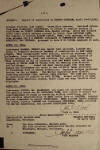
|
9.
22 April 1931.
Report of operations in PUERTO CABEZAS,
for period April 12-17, 1931.
Captain John C.
Wood, Bluefields, to Area
Commander Col. John Marston, Bluefields,
p. 9.
"[...] -9- ¶
SUBJECT: Report of operations in PUERTO
CABEZAS, April 12-17, 1931. ¶ ..dropped
fourteen (14) bombs. Casualties unknown.
Received orders from Area Commander,
BLUEFIELDS, to return to regular station
if conditions in PUERTO CABEZAS were
fairly stable. About one hundred fifty
(150) native refugees arrived by train,
from RAILROAD LINE. The remains of
Captain HARLEN PEFLEY, USMC, with
personal effects, were shipped via S S
CEFALU, consigned to COMMANDANT EIGHT
NAVAL DISTRICT, NEW ORLEANS. Arranged to
have K23 bridge repaired at once. ¶
APRIL 16, 1931. Lieutenant DARRAH,
CURCEY and twenty (20) enlisted, cleared
via train to disperse wholesale looters
of commissaries in NEW VANCE TRACT. They
accomplished their mission, arresting
eighteen (18) offenders, local
inhabitants, and brought in a large
quantity of stolen merchandise, food,
and clothing for return to owners. They
proceeded as far as possible into NEW
VANCE TRACT, and were stopped at KIPLA
FARM by flames from the burning farm
district and buildings. Armed and sent
twenty-eight (28) farm mandadors and
assistants via train to the northern
farms districts to reorganize work of
banana production. Repaired bridges
permitted trains, as far as SNAKI. Two
Marine amphibians made circuits,
observing RAILROAD LINE, SAKLIN, CAPE
GRACIAS. The LINE was quiet. No
indications of bandits on COCO RIVER.
Normal activity at CAPE GRACIAS, with
American, German, white flags and sign
“Bandits Gone” displayed. ¶ APRIL 17,
1931. Lieutenant CURCEY, Mr. BEARDSLEY,
and eight (8) enlisted cleared via
Gasoline motorcar to LOUISIANA FARM,
with orders to assist the superintendent
of farms in restoring working
conditions, and to get positive
identification of dead bandit jefe at
LOGTON. Ordered by Area Commander to
return BLUEFIELDS. 2020 Cleared PUERTO
CABEZAS via plane, Captain JOHNSON and
Lieutenant SCHRIEDER, USMC, piloting two
Marine amphibians, and arrived
BLUEFIELDS 1220. ¶ (signed) JOHN C. WOOD
¶ First Endorsement ¶ HEADQUARTERS
EASTERN AREA GUARDIA NACIONAL. ¶
Bluefields, Nicaragua 23 April 1931 ¶
From: TheArea Commander, Eastern Area. ¶
To: The Jefe Director, Headquarters
Guardia Nacional de Nicargua, Managua,
Nicaragua. ¶ 1. FORWARDED. ¶ (SIGNED)
JOHN MARSTON [...]"
|
|
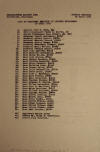
|
10.
22 April 1931.
Report of operations in PUERTO CABEZAS,
for period April 12-17, 1931.
Captain John C.
Wood, Bluefields, to Area
Commander Col. John Marston, Bluefields,
p. 10.
"[...]
HEADQUARTERS EASTERN AREA GUARDIA
NACIONAL ¶ Bluefields, Nicaragua 22
April 1931 ¶ LIST OF PERSONNEL EMPLOYED
IN LOGTOWN ENGAGEMENT ¶ 13 APRIL 1931 ¶
1. Captain John C. Wood, GN ¶ 2. First
Lieutenant Clyde R. Darrah, GN ¶ 3.
Second Lieutenant Tony Simmer, GN, (MC)
¶ 4. Sergeant Lazaro Guatemala, #3557 ¶
5. Sergeant Arthur Taylor, #2705 ¶ 6.
Sergeant Eduardo Toruno, #1255 ¶ 7.
Sergeant Adrian Saenz, #3486 ¶ 8.
Corporal Sebastian Jimenez, #3427 ¶ 9.
Corporal Earix Watson, #2662 ¶ 10.
Corporal Joaquin Zelaya, #1838 ¶ 11.
Raso Jose Aguirez, #3310 ¶ 12. Raso
Marcelin Basquedano, #2588 ¶ 13. Raso
Abram Balles, #2658 ¶ 14. Raso Jose
Balles, #3421 ¶ 15. Raso Simeon Blandon,
#3422 ¶ 16. Raso Charles Casanova, #2593
¶ 17. Raso Sabas Cornejo, #3473 ¶ 18.
Raso Felicito Cruz, #1943 ¶ 19. Raso
Thomas Davis, #3027 ¶ 20. Raso Julio
Delgadillo, #3730 ¶ 21. Raso Pedro
Duran, #3425 ¶ 22. Raso Jose J.
Espinoza, #3488 ¶ 23. Raso Dave Flores,
#2852 ¶ 24. Raso Emil Groniwald, #2414 ¶
25. Raso Justino Flete, #3362 ¶ 26. Raso
Armando T. Harvey, #3746 ¶ 27. Raso
Vivian Hernandez, #3004 ¶ 28. Raso Juan
B. Martinez, #3479 ¶ 29. Raso Mateo
Martinez, #3477 ¶ 30. Raso Gifford
Robinson, #2602 ¶ 31. Raso Orgando
Rojero, #2854 ¶ 32. Raso Rafael Rosales,
#2214 ¶ 33. Raso Manuel Seas, #3487 ¶
34. Raso Nicho Simeon, #2441 ¶ 35. Raso
Daniel Urbina, #3482 ¶ 36. Raso Diego
Vasquez, #3429 ¶ 37. Raso Felton Wilson,
32547 ¶ 38. Raso Julian Zepeda,#2259 ¶
39. Raso Levi Pinnock, #4281 ¶ 40.
Applicant Emilio Arraz ¶ 41. Civico Mr.
RalphR. Beardsley. ¶ 42. Civico Jose
Talavera. [...]"
|
|
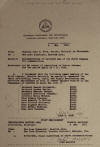
|
11.
22 April 1931.
Report of operations in PUERTO CABEZAS,
for period April 12-17, 1931.
Captain John C.
Wood, Bluefields, to Area
Commander Col. John Marston, Bluefields,
p. 11.
"[...] 4 May 1931
¶ From: Captain John C. Wood, Guardia
Nacional de Nicaragua. ¶ To: The Area
Commander, Eastern Area. ¶ Subject:
Recommendation of enlisted men of the
Ninth Company for commendation. ¶
Reference: (a) My report of operations
in Puerto Cabezas for the period April
12 – 17, 1931. ¶ 1. I recommend that the
following named members of the Ninth
Company Guardia Nacional, be specially
commended for their outstanding, brave,
loyal, and highly meritorious and
effective performance of duty in combat
against bandits in the engagement of
Logtown on April 13, 1931 :-- ¶ Sergeant
Lazaro Guatemala, #3637 ¶ Sergeant
Arthur Taylor #2705 ¶ Sergeant Eduardo
Toruno, #1355 ¶ Corporal Sebatian
Jimenze, #3427 ¶ Corporal Earix Watson,
#2652 ¶ Raso Simeon Blandon, #3422 ¶
Raso Armando T. Harvey, #3746 ¶ Raso
Gifford Robinson, #2602 ¶ Raso Orgando
Mojero, #2854 ¶ Raso Rafael Rosales,
#2214 ¶ Raso Levi Pinnock, #4281 ¶
(signed) JOHN C. WOOD ¶ FIRST
ENDORSEMENT HEADWQUARTERS EASTERN AREA
GUARDIA NACIONAL ¶ Bluefields, Nicaragua
4 May 1931 ¶ From: The Area Commander,
Eastern Area. ¶ To: The Jefe Director,
Guardia Nacional, Managua, Nic. ¶ 1.
Forwarded, fully concurring in above
recommendations. ¶ (signed) JOHN
MARSTON"
|
|
|
|
|
PREVIOUS
NEXT
|
|
|
|
|
|
|
|

